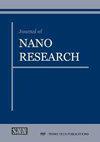Photocatalytic Degradation of Orange II by Active Layers of Ag-Doped CuO Deposited by Spin-Coating Method
IF 1
4区 材料科学
Q4 MATERIALS SCIENCE, MULTIDISCIPLINARY
引用次数: 1
Abstract
In this work we studied the effect of doping on heterogeneous photocatalysis application we used the samples CuO, 5% Ag:CuO, 15% Ag:CuO, 25% Ag:CuO and 50% Ag:CuO catalysts thin layers which were prepared by the sol gel method on a glass substrate. The structural, morphological, optical and electrical characteristics of these layers were studied by XRD, IR, SEM, UV-Vis spectrophotometry and four-point analysis. The results of the XRD, it is observed that the structure of the monoclinic phase develops, with preferential orientations following the plane (-111). This indicated that the thin films are polycrystalline, these results and confirmed by the IR spectra. In the case of Ag doping the SEM revealed the creation of pores on the surface of the samples, which enhanced the degradation of orange II under UV light. The gap energy decreases from 2.17 eV to 1.25 eV with increasing doping. These results show that thin films doped with Ag exhibit a higher degradation than that obtained by pure CuO. After 5 hours in the case of doping with 50% Ag the percentage of degradation is 43%, on the other hand in the pure case the percentage of degradation is 27%.With this, it can be said that 50% Ag:CuO is a good catalyst because the sample has pores, and therefore a larger catalytic area. Creating pores on the surface of the samples, obtaining a less energy gap enables the creation of a greater number of •Oand OH• that works to disintegrate the dye and give the white color to the solution.旋涂法制备掺银CuO活性层光催化降解橙ⅱ
本文采用溶胶-凝胶法制备了CuO、5% Ag:CuO、15% Ag:CuO、25% Ag:CuO和50% Ag:CuO的催化剂薄层,并在玻璃衬底上研究了掺杂对非均相光催化应用的影响。采用XRD、IR、SEM、UV-Vis分光光度法和四点分析等方法研究了这些层的结构、形貌、光学和电学特性。XRD结果表明,单斜相结构发育,取向优先沿平面(-111)。这表明薄膜是多晶的,这些结果得到了红外光谱的证实。在Ag掺杂的情况下,扫描电镜显示样品表面产生了孔隙,这增强了紫外光下橙色II的降解。随着掺杂量的增加,间隙能从2.17 eV降低到1.25 eV。这些结果表明,掺杂Ag的薄膜比纯CuO的薄膜表现出更高的降解。在掺杂50% Ag的情况下,5小时后降解率为43%,而在纯情况下,降解率为27%。由此可见,50% Ag:CuO是一种很好的催化剂,因为样品具有孔隙,因此具有较大的催化面积。在样品表面形成孔隙,获得更小的能量间隙,可以产生更多的•o和OH•,从而分解染料并使溶液呈现白色。
本文章由计算机程序翻译,如有差异,请以英文原文为准。
求助全文
约1分钟内获得全文
求助全文
来源期刊

Journal of Nano Research
工程技术-材料科学:综合
CiteScore
2.40
自引率
5.90%
发文量
55
审稿时长
4 months
期刊介绍:
"Journal of Nano Research" (JNanoR) is a multidisciplinary journal, which publishes high quality scientific and engineering papers on all aspects of research in the area of nanoscience and nanotechnologies and wide practical application of achieved results.
"Journal of Nano Research" is one of the largest periodicals in the field of nanoscience and nanotechnologies. All papers are peer-reviewed and edited.
Authors retain the right to publish an extended and significantly updated version in another periodical.
 求助内容:
求助内容: 应助结果提醒方式:
应助结果提醒方式:


